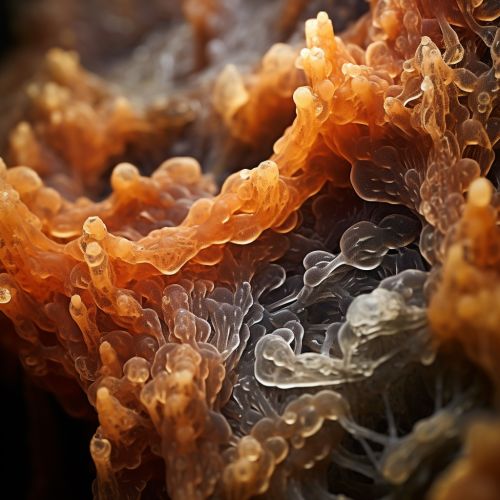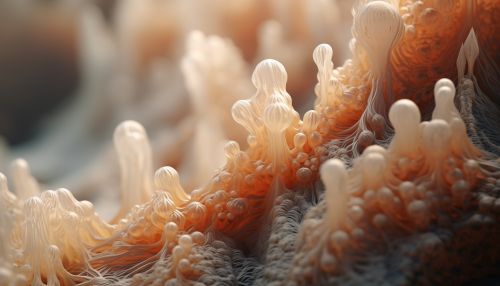The Role of Biofilms in Environmental and Industrial Processes
Introduction
Biofilms are structured communities of microorganisms that are enclosed within a self-produced polymeric matrix, adhering to each other and usually to a surface. These complex, multicellular communities of bacteria and other microorganisms play a significant role in both environmental and industrial processes. This article will explore the role of biofilms in these contexts, delving into the specifics of their formation, characteristics, and their impact on various environmental and industrial processes.
Biofilm Formation and Characteristics
Biofilms form when free-floating microorganisms adhere to a surface and begin to excrete a slimy, glue-like substance that anchors them to all kinds of material – such as metals, plastics, soil particles, medical implant materials, and tissue cells. The formation of biofilms involves several stages: initial attachment, irreversible attachment, maturation I, maturation II, and dispersion. Each of these stages involves complex biochemical and physical signals.


Biofilms are characterized by a number of features that make them distinct from free-floating (planktonic) bacteria. These include the production of extracellular polymeric substances (EPS), the formation of microcolonies, and the development of complex three-dimensional structures. Biofilms also exhibit a number of unique properties, such as increased resistance to antimicrobial agents and the ability to withstand harsh environmental conditions.
Role of Biofilms in Environmental Processes
Biofilms play a significant role in various environmental processes. They are involved in nutrient cycling, the breakdown of organic materials, and the formation of soils. They can also influence the mobility and bioavailability of contaminants in the environment.
Nutrient Cycling
Biofilms play a crucial role in nutrient cycling in the environment. They are involved in the cycling of key nutrients such as carbon, nitrogen, and phosphorus. For example, biofilms in aquatic environments play a key role in the nitrogen cycle, participating in processes such as nitrification and denitrification.
Organic Material Breakdown
Biofilms are also involved in the breakdown of organic materials in the environment. This is particularly important in the context of wastewater treatment, where biofilms are used to break down organic pollutants in wastewater.
Soil Formation
Biofilms contribute to soil formation by stabilizing soil particles and contributing to the development of soil structure. They also play a role in the cycling of nutrients in soils, contributing to soil fertility.
Contaminant Mobility and Bioavailability
Biofilms can influence the mobility and bioavailability of contaminants in the environment. They can bind to contaminants, reducing their mobility and potentially reducing their bioavailability. This can have implications for the remediation of contaminated sites.
Role of Biofilms in Industrial Processes
In addition to their role in environmental processes, biofilms also play a significant role in various industrial processes. They are used in bioremediation efforts, in the production of biofuels, and in the food and beverage industry. However, they can also pose challenges in industrial settings, particularly in the context of biofouling and biocorrosion.
Bioremediation
Biofilms are used in bioremediation efforts to clean up contaminated environments. They can be used to break down a variety of pollutants, including hydrocarbons, heavy metals, and radionuclides.
Biofuel Production
Biofilms also play a role in the production of biofuels. For example, they are used in the production of bioethanol, where they contribute to the fermentation process.
Food and Beverage Industry
In the food and beverage industry, biofilms are used in fermentation processes. They are also involved in the production of certain types of cheese and vinegar.
Biofouling and Biocorrosion
While biofilms can be beneficial in certain industrial processes, they can also pose challenges. One of the main challenges is biofouling, where biofilms form on surfaces and cause problems such as reduced heat transfer, increased pressure drop, and increased corrosion rates. This can have significant implications for industries such as water treatment, food processing, and the maritime industry.
Conclusion
Biofilms play a significant role in both environmental and industrial processes. They are involved in nutrient cycling, the breakdown of organic materials, soil formation, and the remediation of contaminated sites. They are also used in various industrial processes, including the production of biofuels and in the food and beverage industry. However, they can also pose challenges in industrial settings, particularly in the context of biofouling and biocorrosion. Understanding the role of biofilms in these processes is crucial for both environmental management and industrial applications.
